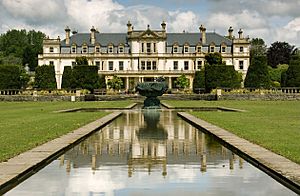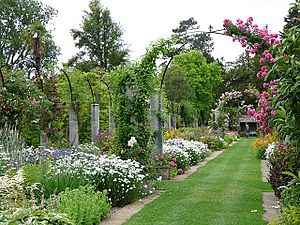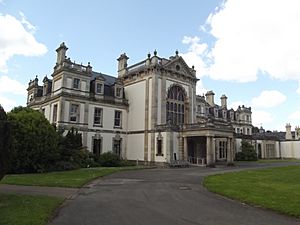Dyffryn Gardens facts for kids
Quick facts for kids Dyffryn Gardens |
|
|---|---|

Dyffryn House from the Great Lawn
|
|
| Type | Botanic garden and arboretum |
| Location | Dyffryn, Vale of Glamorgan, Wales |
| Area | 34 hectares |
| Operated by | National Trust |
| Open | All year (363 days) Opens from 10:00, see website for details |
| Website | National Trust: Dyffryn Gardens |
| Dyffryn Gardens | |
|---|---|
| Welsh: Gerddi Dyffryn | |
 |
|
|
Listed Building – Grade II
|
|
| Official name: Lower South Terrace at Dyffryn Gardens (partly in St Nicholas and Bonvilston Community) | |
| Designated | 10 October 2002 |
| Reference no. | 26988 |
Dyffryn Gardens (which means Gerddi Dyffryn in Welsh) is a beautiful collection of botanical gardens. You can find them near the villages of Dyffryn and St. Nicholas in the Vale of Glamorgan, Wales. These gardens are so special that the British Tourist Authority once named them one of the Top 100 gardens in the whole UK! Today, the National Trust takes care of them.
Discovering Dyffryn Gardens' Past
The story of Dyffryn Estate goes way back to 640 A.D. That's when the land, called the Manor of Worlton, was given to Bishop Oudoceus of Llandaff.
Early Owners: The Button Family
In the 1500s, the Button family rented the Manor of Worlton. They lived in a place called Dog Hill in Dyffryn first. Later, they built another home, Columbar, which is thought to be where Dyffryn Gardens stands today. The Button family lived on the estate for many years. One famous member was Admiral Thomas Button, an important early explorer.
New Beginnings with Thomas Pryce
In the 1700s, the estate was sold to Thomas Pryce. He changed its name to the Manor of Dyffryn, St Nicholas. In 1749, Pryce built the second Dyffryn House, a grand Georgian-style manor. He also started adding things to the grounds, like a walled garden and some pretty plants.
John Cory and the Grand Design
In 1891, a wealthy man named John Cory bought the Dyffryn Estate. He started building the current Dyffryn House in 1893. To make the gardens just as grand as the new house, Cory hired Thomas Mawson. Mawson was a very famous landscape architect. He began designing the gardens in 1894, and they were finished in 1909.
Reginald Cory's Plant Adventures
After John Cory passed away in 1910, his son Reginald took over the estate. Reginald was a huge fan of plants and a leading figure in the Royal Horticultural Society. He loved collecting plants from all over the world! In the early 1900s, he even helped pay for plant hunting trips. Many of the unique plants you see at Dyffryn today came from these trips. For example, the amazing Acer griseum (Paper Bark Maple) grew from seeds brought from China by the famous plant hunter Ernest Wilson.
Changes in Ownership and Restoration
After Reginald's death in 1934, the estate went to his sister Florence. Then, in 1937, Sir Cennydd Traherne bought it. In 1939, Sir Cennydd leased Dyffryn House and Gardens to Glamorgan County Council. They used it as a botanical garden for a very long time.
In 2000, a group called Cadw gave the gardens a special "Grade II" status. This means they are recognized as very important historical landscapes in Wales. The experts said, "The gardens at Dyffryn are the grandest and most outstanding Edwardian gardens in Wales."
The gardens got a huge makeover in 2006 with an £8 million grant. This money helped restore the Edwardian gardens to how Thomas Mawson originally designed them for John Cory. Finally, in January 2013, the National Trust took over caring for Dyffryn House and Gardens.
Exploring Dyffryn House
| Dyffryn House | |
|---|---|
| Welsh: Tŷ Dyffryn | |
 |
|
|
Listed Building – Grade II
|
|
| Official name: Dyffryn House | |
| Designated | 15 September 1992 |
| Reference no. | 13469 |
The Dyffryn House you see today was built between 1893 and 1894 for John Cory. It was designed by architect E.A. Lansdowne. This house was one of the last big country mansions built in Wales. It's a long, narrow building with a style similar to the Second French Empire.
Inside the Grand Manor
When you enter the house from the north side, you'll go through a covered entrance called a porte-cochere. This leads into a tall, impressive hall. The windows in the hall show pictures of Queen Elizabeth I at Tilbury. The hall also has a magnificent chimneypiece. It features a marble design from the late 1600s, with wooden figures of Ceres (the goddess of agriculture) and Prudence on either side.
Other interesting rooms include the Oak Room, which has a chimneypiece with six-winged cherubim. The drawing room and boudoir have beautiful mantle-pieces made of alabaster.
Dyffryn House Today
Even with all its grand features, the house has been used for different things. It was once a police training center and later a conference center. In 2007, money was spent to fix the house's walls and roof. Since March 2013, after a lot of restoration work, the house is now open for everyone to visit.
The Amazing Dyffryn Gardens
Dyffryn Gardens is a popular place to visit, open almost every day of the year. When you arrive, you'll go through the admissions building, which also has a shop and a tea-room. From there, the gardens are split into three main parts: the arboretum, Dyffryn House and its lawns, and the Garden Rooms.
The Arboretum and Lawns
The eastern side of the gardens is the largest and holds the arboretum. An arboretum is like a tree museum, with many different kinds of trees. This area starts near the kennel bank and leads to a rockery.
In the middle of the gardens, you'll find Dyffryn House and its wide lawns. The lawns stretch from the house southwards to the Vine Walk. The Vine Walk is a series of arches, each with a different type of climbing vine.
There are two main lawns. The croquet lawn is closest to Dyffryn House. The Great Lawn runs north to south and has a long canal in the middle. In the center of the canal is a large bronze fountain. This fountain is in a Chinese style and has a bronze Chinese Dragon wrapped around it. At the very end of the Great Lawn is a fountain pool. The two bronze statues that used to be here, Fujin and Raijin (Japanese gods of wind and lightning), are now kept safely in the glasshouses. At the southern end of the lawns, you'll also find the Lavender Garden, which has a fun red brick "folly" (a building built just for decoration).
The Garden Rooms
The last part of the gardens is called the Garden Rooms. These are a series of themed gardens, like different "rooms" outdoors. They are built on terraces.
- Italian Terrace: This area has plants and designs inspired by Italy.
- Australasian and Mediterranean Gardens: These gardens feature plants from Australia, New Zealand, and the Mediterranean region.
- Other Themed Areas: You can also find a physic garden (for medicinal plants), a beautiful rose garden, a calm reflecting pool, and Pompeian gardens. The Pompeian gardens, entered through an archway from 1909, were inspired by Reginald Cory's trips to Italy.
All around the gardens, you'll see many statues. Many of them show people with animals. Look out for a stone lion lying down, a terracotta statue of a woman holding a palm, and a large bronze statue of a mandarin riding a bull behind the house.


